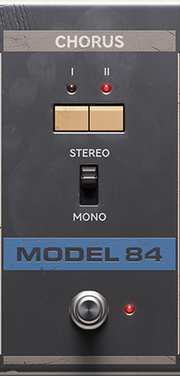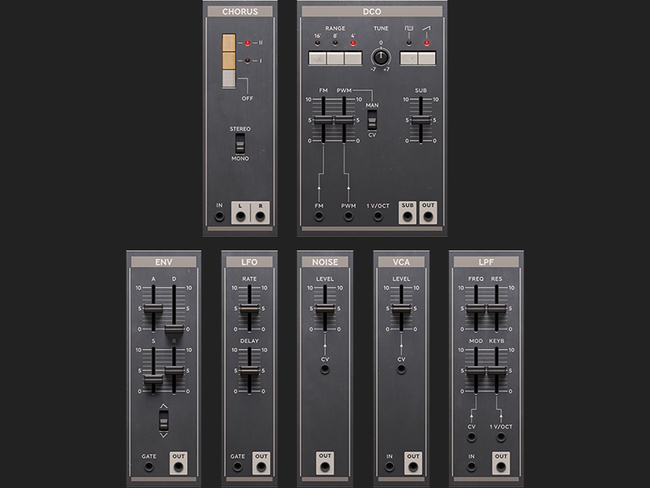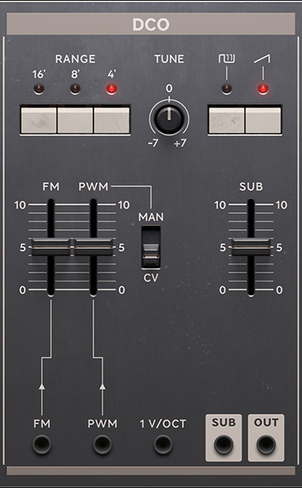- hot!
- sale
- award
- top rated
The Resurrection of a Polyphonic Icon
- An 80s-era icon of polyphonic synthesizing faithfully emulated through circuit modelling on a component level.
- The true-to-the-original sound and unique features of the revered hardware—such as two poly modes with proper voice allocation—plus fresh innovations.
- Three versions included: instrument, a chorus for Amp Room, and seven modules for Modular.
The year is 1984. Splashing down is a majorly righteous polyphonic synthesizer that will go on to outrun its era. Thirty-odd years later, Softube are still vibing on the gnarly Synthwave reverberations this paragon can produce. Used on countless records by innumerable artists, it’s a six-voice synth that set a standard and established a sound. Now it’s time to discover what it can do in the DAW.
Softube applied their award-winning modelling expertise to a fully-serviced and calibrated 1984 unit and the result is a perfect facsimile of the original hardware. Using rock & roll science, Softube have created a plugin that has all the quirks and non-linearities of the 1980s-era idol. Even the clutch factory presets with easy recall of the '80s sounds heard on copious number-one hits. Added features and flexibility bring the prototype’s influential and unmistakable sound motoring into modern production environs: from Softube's official Eurorack platform, Modular, to Softube's pro audio guitar & bass platform, Amp Room—and beyond.
Introducing the most excellent Model 84 Polyphonic Synthesizer. The retro-future is here.
Designed by Experts, Built on Legacy
Softube has a decades-long history of modelling premium audio gear in concert with professional audio brands like Tube-Tech, Solid State Logic, Chandler Limited®, Weiss Engineering, and Trident. Softube's track record of flawlessly recreating hardware classics in software form is well-established. It's an expertise that extends to synthesizer plugins like Modular and Model 72.
Model 84 is built on this legacy. Softube used the same exacting standards and skills—precise testing and experienced fine-tuning—and the outcome is sound quality that equals the hardware. Or, in terms of clarity, surpasses it. Always more, nothing less.
The Model: An Authentic Emulation
Softube poured the same fastidious modelling energy into Model 84 Polyphonic Synthesizer that goes into every piece of their gear. The result is voice allocation modes and an EQ—with bass boost for extra oomph on basslines—that mirror the iconic hardware.
Softube's meticulous recreation of the unison phase allows you to assign all six voices to one note and to achieve the sounds of the synth that became an industry touchstone.
Control: Added Features
Model 84 is about control. Extended unison mode gives authority over sync and enables a more pronounced attack to the start of a note. Velocity and aftertouch support promote enhanced dynamic performance with command over the amp, as well as the filter and PW. And the expanded control panel, with added velocity and aftertouch parameters, makes it easier to fine-tune sound and behaviour. Get ‘80s mojo in the digital domain—your way.
The Presets: Original & Contemporary
Get the authentic sound of the Decade of Greed without spending a second fussing with knobs. Model 84 comes packed with both the original presets as well as striking new artist presets. Quickly recall classic sounds, original patches, distorted bass sounds, and the Synthwave heard on so many classic and contemporary albums. Or set it to stun with incredible artist presets that range from retro sounds to modern-day fat- and wide-sounding crispy leads.
Sweet Synthesis: The Modular Modules
The synth sound made classic in the 1980s is now available in Modular. Seven fully integrated modules allow you to easily combine pieces of the Model 84 Polyphonic Synthesizer in a modular workflow. Artistically patch Model 84 modules with other Modular-ready gear like the monophonic legend, Model 72—a feat previously impossible in both digital and analogue realms. Model 84 delivers universe-expanding capabilities and mind-blowing creative possibilities to the Modular ecosystem.
Electric Friends: The Amp Room Module
Model 84's Chorus is a totally unique and brand-new module for Amp Room. Previously unavailable on the pro audio guitar and bass platform, you can now create bodacious guitar or bass sounds with the chorus used in the original keyboard synthesizer and as a design inspiration on a famous guitar stompbox from the Decade of Decadence and big hair. Powerfully dirty and fat, Chorus produces a distinct sound that adds mega wattage to your creativity.
User Interface
Low-Frequency Oscillator
The LFO section is used for modulation in Model 84. It can be applied to pitch (vibrato), PWM (pulse width modulation of the square wave), or to modulate filter cut-off frequency.

Digitally-Controlled Analog Oscillators
The heart of the Model 84 Polyphonic Synthesizer is the DCO section. It sets up the type of harmonic or nonharmonic content that is shaped by the LPF, VCA, EQ, and Chorus.

Low Pass Filter
The LPF section contains a filter that shapes the sound of the oscillators’ overtones. It will make the sound duller when you lower the cutoff frequency, and brighter when you raise the cut-off frequency.

Pitch & Modulation Wheels
The parameters of the PITCH and MOD performance modulation section determine how much the pitch-bend and modulation wheel on your keyboard will affect the pitch, filter, and vibrato.

Glide Time & Voice Allocation
In the GLIDE section, you can set the glide time between each note. The VOICING section is where you choose the voice allocation mode of either Poly 1, Poly 2, or Unison.

Envelope Generator
The Envelope Generator is used to describe time-based changes in a sound. Using the Attack (A), Decay (D), Sustain (S), and Release (R) sliders, the Model 84 Envelope Generators can be used to shape either the harmonic content of the sound or the amplitude of the played sound. Or both at the same time.

Voltage-Controlled Amplifier
The VCA section of Model 84 determines the behaviour (gated or enveloped) and bias of the voltage-controlled amplifier going into the EQ and Chorus sections.

Equalization & Chorus
The EQ and Chorus sections are home to a simple four-preset EQ and a stereo chorus that are the icing on the cake of the legendary Model 84 Polyphonic Synthesizer sound.

Tricks and Treats
Model 84 is a highly accurate emulation of the storied polyphonic synthesizer that became a music industry staple. Every trait, trick, and mannerism of the original hardware is now available to you in software form.
You get the unadulterated sound and behaviour of the original with dead perfect execution every time. The mod-wheel and pitch-wheel assignments affect your pitch, filter, and vibrato in the software the same as they would in the original 1980s gear. The perfectly recreated LPF tracking allows you to play the filter when self-oscillating, just like in the 1984 model unit. And the glide function gives you proper voice allocation—even when the sustain pedal is held down—encouraging wonderfully creative playing techniques in the two poly modes. Just like the original. With the true-blue authentic Model 84 Polyphonic Synthesizer plug-in, you get the best of the quintessential '80s sound right in your DAW. No shoulder pads or feathered hair required.
What’s Included?
Model 84 Polyphonic Synthesizer
From the lushness of the 1980s to today's Synthwave revival, the musical performance of this keyboard has helped it earn icon status. Softube's rigorous modelling of the voice modes makes for highly accurate voice allocation of chords and legato passages. The pitch and mod wheel, MIDI CC, and velocity/aftertouch support ensure it's an instrument that can be performed naturally. Use it to create the sounds this synth is so well-known for.

Model 84 Chorus for Amp Room
The super-smooth Model 84 module for Amp Room offers the powerful, dirty, and fat Chorus. The module is stellar for guitar processing and the creation of lush sounds for bass, guitar, and keyboards. Used in the original hardware and as inspiration for the design of the famous guitar stompbox, Chorus provides a “dirty chorus” sound that’s hyper-specific and prone to inciting outbursts of outrageous creative production ideas.

Model 84 for Modular
Model 84 for Modular offers seven fully integrated instrument sections as individual modules. Ready to add to your Eurorack system, this legendary synth inputs pure creativity and inspiration with every module. It’s simple to combine single components of the synthesizer in a modular workflow to build patches—or one monster synth patch!—and get authentically retro polyphonic sounds. With Model 84, you can create combinations in Modular that were never-before-possible—via hardware or software.

The Modular Modules
Chorus
Use the Chorus mode buttons to change the operational mode of the chorus (off, I, II). The Chorus Mono/Stereo Switch changes the output mode of the chorus between mono and stereo. Be careful with high-input signals. This module will distort just like the original hardware.

DCO
The PW/PWM switch determines whether an external signal controls the pulse-width of the pulse waveform (when the PW/PWM switch is set to CV), or if the set slider position will define the manual pulse-width (PW/PWM set to MAN). The main output is combined output with the mixed waveforms (sawtooth, pulse, and sub-oscillator post-Sub Level). The output is about +- 7.5V when all the waves are summed.

Envelope
The gate input jack starts the envelope when high (triggers when crossing 2.5V on a rising flank) and initiates the release phase when set low again. The output envelope modulation signal of the envelope (0 - 10V when positive, 0 - -10V when negative) can be used to modulate VCA levels, LPF cut-off frequencies, or DCO pitch for bends.

LFO
The gate input jack triggers the delay fade-in period for the LFO waveform. When a positive gate signal is received here (crossing 2.5V on a rising flank), the LFO will reset to 0 and slowly fade-up by the rate set by the LFO delay slider. The output of the LFO triangular waveform of the Model 84 LFO at +-5V. Use this for vibrato.

Noise
The slider sets the initial level of the noise when the CV jack is not connected and sets the scaling of the input signal when connected to an external modifier or modulator. The external CV input jack is used to externally control the level of the noise in the Model 84 Noise module. CV in at 0 to 5V will mimic the fader. Above this value will be clipped.

VCA
Input the signal that you want to attenuate through the VCA via audio input. CV-in is the input for the external signal to control the VCA. Input CV 0 to 5V will mimic the fader. Anything above will be clipped. The level attenuator slider here sets the initial level of the Model 84 VCA when the CV jack is not connected and will set the scaling of the input signal when connected to an external modifier or modulator.

LPF
The keyboard CV input jack can be used for external keyboard modulation of the filter cut-off frequency. When the Keyboard track attenuator slider is set to full, the filter will track 1 v/octave via the Keyboard CV jack. The output jack of the Model 84 LPF module puts out the lowpass-filtered version of whatever signal is fed into the filter.

Features
- The authentic sound of the 1980s in plug-in and module form
- Meticulously modelled on a pristine 1984 polyphonic synthesizer
- Three versions included: Model 84 Instrument, Model 84 Chorus module for Softube Amp Room, and seven Model 84 modules for Softube Modular.
- The unison phase sounds of the original
- Factory presets for easy recall of classic sounds
- Stunning artist presets—from classic sounds to contemporary, crispy leads
- Increased velocity and aftertouch support for added control over the amp, filter, and PW
- The addition of extended unison mode for higher control over sync
- An expanded control panel with added parameters for finetuning
- Pitch and mod wheel assignment, glide, and voice allocation for creative playing
System Requirements
- macOS Big Sur 11, Monterey 12, Ventura 13
- Windows 10 (64-bit), Windows 11
- Softube account
- iLok account
- Computer with AU, VST, VST3, and/or AAX-compatible DAW host software
- Internet access (for downloading installers and managing licenses)
Supported CPU Families
- Apple macOS computers with Intel Core i3/i5/i7 or Apple silicon (M1 or newer) CPU. Apple silicon is supported natively.
- Windows computers with quad-core Intel Core i3/i5/i7 or AMD quad-core processors with SSE 4.2 support.
- Other Intel processors (Celeron, Pentium, and Xeon) are compatible if they support SSE 4.2 instructions.
Supported Host Software (DAW)
Any 64-bit VST, VST3, AU, or AAX (Pro Tools 11.0.2 or higher) compatible host application should work. However, due to plug-in host differences between DAWs—and our rigorous standards—Softube only officially test their plug-ins and instruments in the most recent versions of Pro Tools, Logic Pro, Cubase, Ableton Live, Studio One, and Reaper. Softube plug-ins are not tested regularly in non-listed systems. They will likely work if the system requirements are met. However, the manufacturer cannot guarantee a solution for issues in unsupported systems.
Softube strongly recommend using VST3, as some of their plug-ins have features that are not present in the older VST format. Supported sample rates: 44.1, 48, 88.2, 96, 176.4, and 192 kHz, in both mono and stereo. The most recent maintenance release of your DAW application is recommended. AAX DSP is not currently in active development. TDM/VENUE/RTAS are no longer supported. See Legacy Installers.
Important Note: Make sure that you always use the latest iLok License Manager. It is not included in the Softube installer but can be downloaded from www.ilok.com
Any references to any brands on this site/page, including reference to brands and instruments, are provided for description purposes only. For example references to instrument brands are provided to describe the sound of the instrument and/or the instrument used in the sample. Plugin Boutique do not have (nor do they claim) any association with or endorsement by these brands. Any goodwill attached to those brands rest with the brand owner. Plugin Boutique or its Suppliers do not accept any liability in relation to the content of the product or the accuracy of the description. "RHODES" is a registered trademark of Joseph A Brandstetter.
Awards
Product Reviews
Softube Model 84 review at MusicTech
Having turned the iconic Minimoog into software gold, Softube has now set its sights on Roland’s iconic Juno-106. We don our luminous socks and...